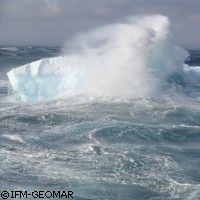How increasing westerly winds are affecting the Southern Ocean
Researchers from Germany and Australia are studying the effect of wind intensification in the southern hemisphere on the Antarctic Circumpolar Current, which has the largest transport volume in the world's oceans, to ascertain its effect on global warming. The study has been published online in the journal Nature Geoscience. The westerly winds of the southern hemisphere are responsible for moving about 140 million cubic metres of ocean water every second. This has a vital role in climate control as the interaction between the winds and current is responsible for transporting a small amount of carbon dioxide emissions from the atmosphere into the depths of the ocean, thereby slowing down the rate of global warming. These winds are now increasing in strength and there are predictions that this will continue in the coming decades. The effect of this increase on the Antarctic Circumpolar Current is now under debate. The Antarctic Circumpolar Current has always been driven by the westerly winds of the southern hemisphere and the interaction between the two is vitally important for exchanges of heat, trace gases and fresh water. The intensification of the winds and their effect on the Antarctic Circumpolar Current is an important topic for research. However, investigations up to now have been hampered by a lack of data due to the practical difficulties facing ship research expeditions in the Southern Ocean. 'In our study we used data obtained by the international Argo Programme,' said Professor Claus Boning of the Leibniz Institute of Marine Sciences (IFM-GEOMAR) in Germany. The Argo Programme has 3,000 free-floating robotic 'drifters', buoys that are constantly taking surveys of the world's oceans. These measure factors such as temperature and salinity levels and transmit them to land-based ocean-monitoring stations via satellite. Archive material from the Australian Marine Research Centre in Tasmania was also used. 'For this study about 52,000 profiles of more than 600 Argo drifters in the Southern Ocean were used and compared with historic ship measurements,' said Astrid Dispert of IFM-GEOMAR. The study proved that water temperature is increasing and salinity is decreasing. But it didn't show a significant increase in water transport. 'Our results point to one important thing,' said Professor Boning. 'Eddies which are currently not resolved in climate models might well be the key process in controlling the transport of the Antarctic Circumpolar Current.' Professor Boning believes that investigations with high-resolution ocean models are now needed. Further observations will confirm if the results are sound. If so, that would be good news for climate change as they indicate that the increasing winds have not significantly affected the transportation of carbon dioxide from the atmosphere into the ocean. 'We need further observations,' said Professor Martin Visbeck of IFM-GEOMAR. 'Thanks to the international Argo observations programme we now have continuous access to data from a worldwide network of more than 3,000 profiling drifters. This is a quantum leap in the field of ocean observations which, together with high-resolution modelling, gives us new insights into long-term changes in the ocean.'
Countries
Australia, Germany



